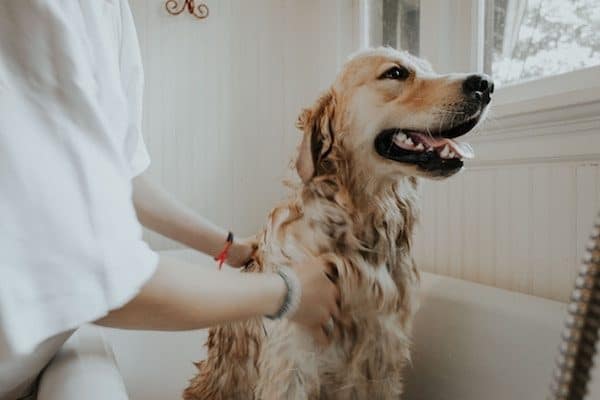In order to get rid of dog smell, things you can try are grooming him, keeping the house clean, buying high-quality air purifiers at home and inside the car.
If you’re a dog lover, you know that a dog can bring a lot of love into your home. But they’re also a lot of work and a big responsibility. Feeding, walking, and training is just the start. Dogs shed, they have health concerns, and all that’s before you have to worry about them getting bored!
A dog is a commitment, and sometimes, it can take some work to learn how to balance the dog’s needs with your own. One of the common problems with your dog is that doggy smell. It can be caused by a variety of problems, from lack of grooming to serious health problems.
Some breeds are more susceptible to oily skin, or skin conditions that can cause a strong smell. If you find yourself constantly fighting to keep the smell of dog out of your home, or car, and it feels like a losing battle, check out this list of tips. We’ll cover common problems with the doggy smell, how to solve them, and what to watch for.
1) Take Your Dog To The Groomer
Doggy smells come from many sources. It may be that your dog spends a lot of time outside. Mud particles, parasites, eating something gross, or spending too much time splashing in puddles obviously contributes to your dog’s cleanliness. But so can the natural oils in your dog’s skin.
At a minimum, it’s advised that you bath your dog, with a dog-friendly mild shampoo every three months. That amount may vary depending on factors that include your dog’s hair length, activity level, and any allergies and skin conditions. Regular brushing can also help combat doggy smells.
Using Dentabone treats and toys designed to fight plaque in your dog’s mouth. No more doggy breath! Along with brushing and bathing at home, you should be taking your dog to a professional groomer every 3 months at least.
Again, this will vary depending on your dog and it’s unique needs. A groomer can help you get rid of tangles, advise you on flea or tick problems, and trim your dog’s nails, as well as basic grooming.
Most groomers are also knowledgeable about skin conditions that can affect your dog, so be open and honest with your groomer about any allergies or conditions your dog may have. Also, it is a good thing to give your dog a bath every 2-3 weeks depending on your dog. Read everything related to bathing your dog the best way in my article.

2) Keep The House Clean
Of course, there’s no point in keeping the dog well-groomed if you let the housework slide! Take care of your home with plenty of sweeping and mopping. You’d be surprised how much dander contributes to that doggy smell.
If you’ve got carpets, rugs, and upholstery, that can make things even worse. A good 90% of what’s in our rugs is dander, pet hair, and grime. It’s not healthy for your family, or your pets. Regularly shampooing carpets, upholstery, and rugs are a great way to keep the pet smell out of your home.
Steam cleaning is another option, though it can be expensive. Alternatively, you can rent a steamer yourself, and do the work of deep cleaning every two to three months. Don’t forget to throw Fido’s bed in the wash while you’re at it! If it fits in a regular tumble dry, you can just run it in the wash as normal, but make sure you run it by itself, to get the most out of the wash cycle.
3) Invest In Pet-Friendly Furniture
If the pet smell and stains in the furniture becomes a bigger problem, consider investing in pet-friendly furniture. Leather is a lot easier to keep clean, and tends to be sturdier too.
It’s not going to absorb scents the way fibrous upholstery does, and you can wipe it down with almost any cleaner, from the green lemon juice or vinegar solutions, or Lysol or baby wipes, with no worries of staining or discoloration.
If outfitting your entire home in leather is a bit of an expense, consider a dog-free space in your home. Put up baby gates and keep your dog trained and out of a particular area in the home.
Help keep the dog from feeling rejected by giving her a room of her own. Choose a small space in the house where you can keep the dog’s bedding, food, and toys.
She’ll get used to having her own space, and it’ll be easier to train her in which rooms are off-limits. Keeping the scent of a dog confined to one room makes the deep cleaning every few months a lot easier on everyone too!
4) Get Yourself A High-Quality Air Purifier
One of the biggest things you can do to protect your home from smells and bacteria is to invest in an air purifier. A good HEPA air purifier may seem a bit of expense at the outset, but they can make a huge difference in the air quality in your home.
Overall, it is estimated that a decent HEPA air filter can rid your home of up to 99.8% of all airborne particles. That means pet dander, dust, and even small odor particles your eye can’t see! That means a healthier living environment for your family and your pets.
Getting an expensive air filtration system installed in your home isn’t even necessary! It’s actually been shown that small, room-sized air purifiers are actually more effective than those that have to cover the entire house. It’s a great solution for anyone with allergies or asthma, too.
Talk to your HVAC company about filters that won’t be too loud for your dog. And remember, with pets, you should be changing the filter system every month or two, not the advised three months. The more pets you have, the more you’ll need to change the filter.
5) Do Regular Checks For Point-Source Problems
Dogs who have accidents tend to go in the same spots over and over. That leads to the concentration of urine and scent in particular spots in the house, which leads to strong ammonia-like smells. There are plenty of ways to discourage your dog from going in the same spots over and over. For example, I discussed stopping digging behavior in another article.
Proper house-training is essential. The myth about old dogs and new tricks isn’t true. Spraying a favored spot with lemon, or other strong scents that repel dogs can stop the repeating behavior while you train or retrain a dog to not go in the house.
If you’re noticing a persistent smell, push furniture away from the walls, to check corners that may be hidden from view. If you spot a space behind the furniture that’s stained and discolored, a mixture of vinegar and water can help get rid of the stains.
A paste of baking soda and water will also bleach while soaking up the scent. You can buy a black light fairly cheaply, and use it to spot any stains faint enough you would have missed them, which may still hold odor particles. Plus, it’s a great chance to get your CSI investigator on!
6) Odor Sealing Paint Is Your Friend
If you’re really stuck, and not sure how to get rid of a pet smell that feels like it’s really baked in? Odor sealing paint can help cut down on the smell. Sometimes, if a dog’s been using a particular spot for weeks or even months, the smell could have seeped into the drywall.
You can replace the drywall, but that can be expensive and time-consuming. Better to use a stain-proof, odor sealing paint. Most paint brands have a variety of options. If you’re really stuck, using these on furniture and floors is also an option.
Don’t think that sealing off the odor will stop it completely. It’s recommended you do a proper deep-clean style scrubbing with strong natural cleaners before repainting. The odor-sealing paint will only help keep odor at bay. It can’t actually get rid of smells already in the walls.
Bonus: How To Keep The Pet Smells Out Of Your Car
We love to travel with our pets. But spending days in a sealed car with your dog is bound to lead to some smelly moments. Fortunately, there are plenty of ways to protect even your car from the strong smell of dog. Here are just a few tips we’ve found.

1) Get Lots of Fresh Air
Make sure to keep the window rolled down as widely and as as possible. Not only is it healthier for the dog, but it also stops the smell from becoming unbearable. Taking plenty of rest breaks with your dog also helps keep the smell from building up.
Rest stops are a great time to get some brushing in, too, which will keep the dog from shedding on the car seats, cutting down on odors.
2) Use A Charcoal Air Freshener
Activated charcoal is a great solution as a car air freshener. The porous surface makes it great for trapping odors, and it’s all-natural. It’s not going to mask one scent with another, making it perfect for families with allergies, asthma or sensitivity.
It’s also perfect for traveling with pets since a dog’s nose is so much more sensitive than ours. He’ll thank you for it!
3) Bring A Vacuum
Travel-sized car vacuums come in many types, sizes, and styles. For those that plug into the dash, you won’t get the same kind of suction power as you would with a wired version. But it’s great for on the go, especially with a pet. Anything can happen, and you want to be able to clean up messes as they occur.
Ask Your Vet: Is Your Dog Healthy?
That doggy smell isn’t exactly pleasant. But it’s just part of what it takes to own a dog. However, there are times when it could be linked to certain health problems. If you’re noticing a particular smell, or all of your cleaning and grooming doesn’t seem to make a difference, you may want to talk to the vet.
A bad doggy smell can mean anything from tooth decay to allergy, to infection, so make sure to get your dog looked at by a vet if these tips don’t help. Senior dogs are also susceptible to metabolic diseases like kidney disease, or even cancer, which can cause your dog to smell different.
Dogs may be our best friends, but they are also a lot of work. And they have ways of making their presence known! To enjoy your dog’s company without suffering his doggy smell, there are plenty of tips to keep in mind, from dealing with a problem after the fact, to stopping an issue before it starts.
You may even be able to consult a vet to check up on your dog’s health and make sure you’re doing everything possible for your furry, four-legged best friend. And don’t forget, it’s better for you, your family, and your home, too!
References
- https://pdfs.semanticscholar.org/b077/dc79d9e96df171429f0b93951adf3f94051a.pdf
- https://www.sciencedirect.com/science/article/pii/S095056015580072X
Table of Contents